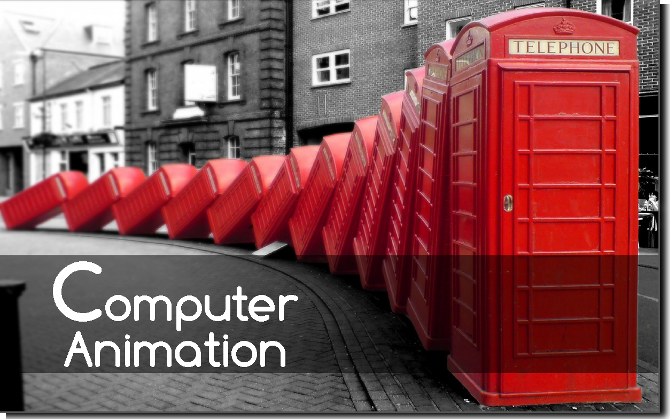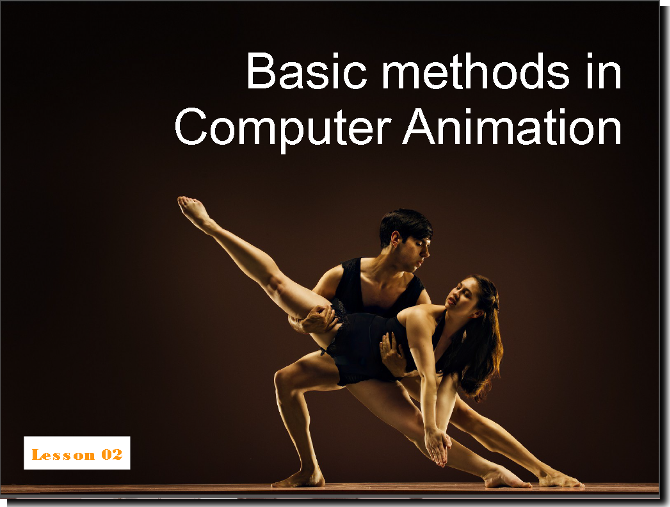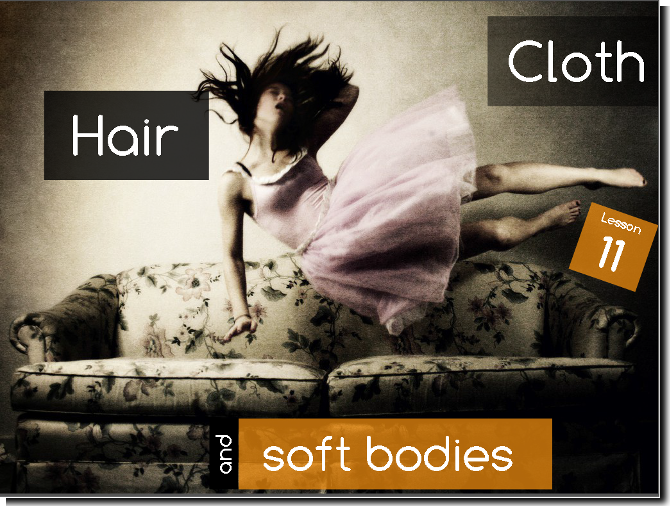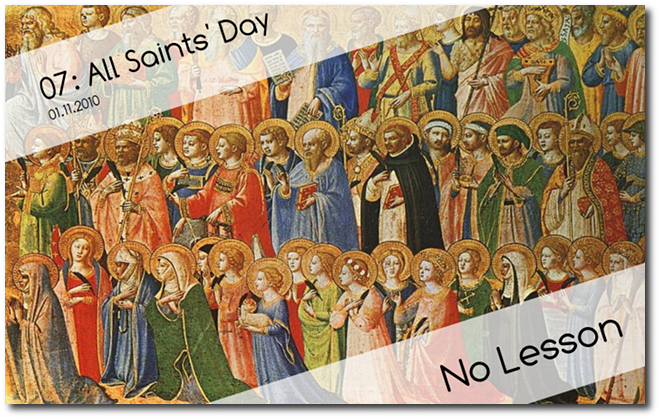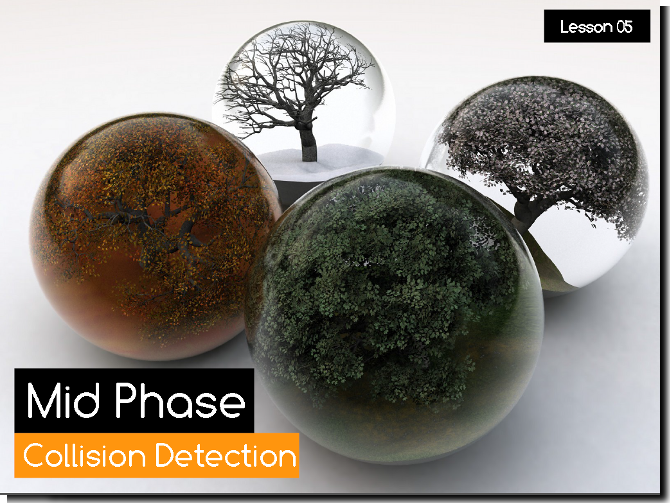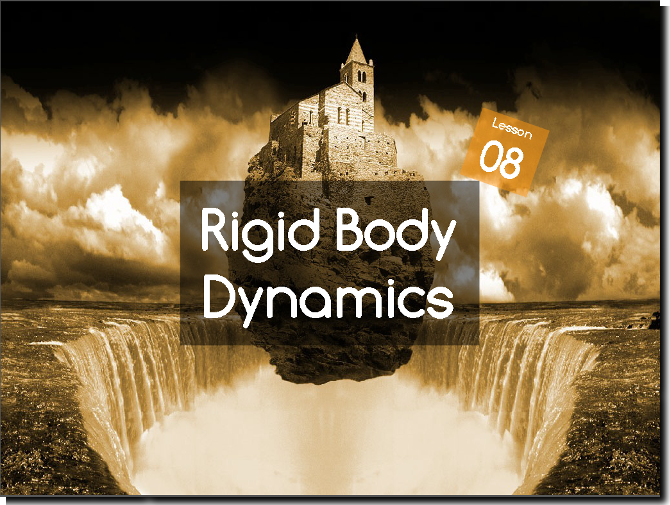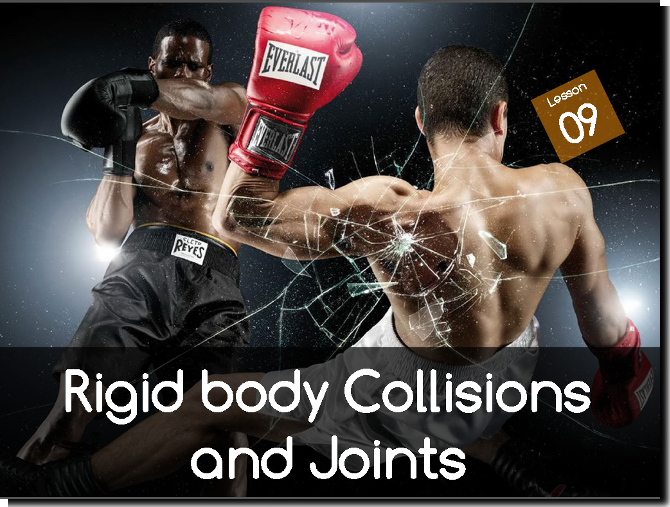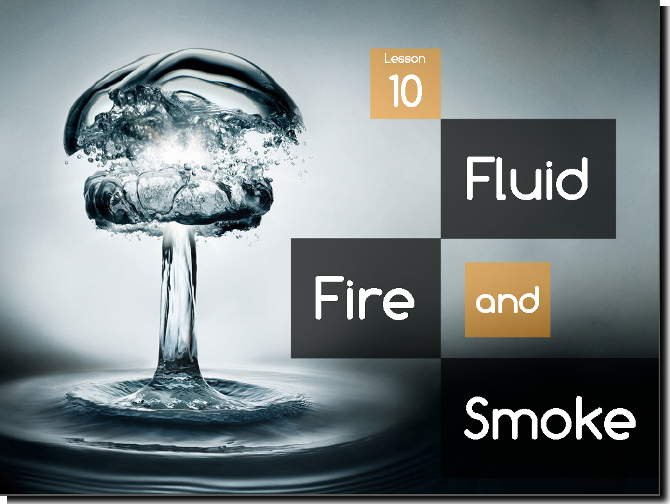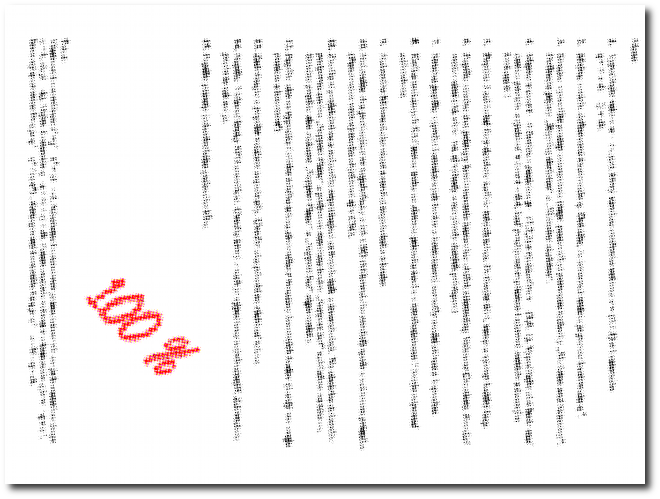Physical based Animations and Mathematical Modelling (Course Materials)
Obsah
- 1 Physical based Animations and Mathematical Modelling (Course Materials)
- 1.1 Student Animation Projects
- 1.2 What you Need to Pass
- 1.2.1 Oral / Written Examination
- 1.2.2 Lesson01 "Introduction to Computer Animation"
- 1.2.3 Lesson02 "Basic methods in Computer Animation"
- 1.2.4 Lesson03 "Particle Systems"
- 1.2.5 Lesson04 "Soft bodies, Cloths and hair”
- 1.2.6 Lesson05 "Broad Phase Collision Detection"
- 1.2.7 Lesson "All Saints' Day (no lesson)"
- 1.2.8 Lesson06 "Mid Phase Collision Detection"
- 1.2.9 Lesson07 "Narrow Phase Collision Detection"
- 1.2.10 Lesson08 "Rigid body Dynamics”
- 1.2.11 Lesson09 "Rigid body Collisions and Joints”
- 1.2.12 Lesson10 "Fluid, Fire and Smoke”
- 1.2.13 Lesson11 "Final term"
- 2 EXCERCISES
- 2.1 Excercise01 "Introductions”
- 2.2 Excercise02 "Quaternion Interpolation”
- 2.3 Excercise03 "Differential Equations”
- 2.4 Excercise04 "Position based Dynamics”
- 2.5 Excercise05 "Particles”
- 2.6 Excercise06 "Collision Detection"
- 2.7 Excercise07 "Separating Axis Theorem”
- 2.8 Excercise08 "Rigid body Dynamics”
- 2.9 RESOURCES
This lecture ...
- Will focus on simulating natural phenomena
- Will show you what are current topics
- Will improve your skills in
- Newtonian physics
- Computational geometry
- Algorithms and data structures
- Hopefully will not be boring
- List of Open Source Physics Engines
Student Animation Projects
- Animácia Hunger
- Stránka Catching Spider Animácia Catching Spider
- Stránka Ráno do práce Animácia Ráno do práce
- Animácia Knihy
- Stránka Tvrdý Oriešok pre Vranu Animácia Vrana
What you Need to Pass
- Attend lessons. All lessons attended is +0 points. Four and more lectures missed you missed the course Fx.
- Solve all homework problems (mandatory each one >=30%, 60 points). All homework assignments must be solved in Wolfram Mathematica or the online version of Wolfram Cloud. Submit the assignment solutions to MS Teams.
- Pass written Final term exam (mandatory each one >=30%, 30 points), no retakes. Realtime problem solution in Wolfram Mathematica or Wolfram Cloud.
- Pass oral/written exam: (optional, +0 .. +20 points) If you feel you are better, convince me ! You can get +20 points max.
- Summary
- Attendance = +0 or -100 (or Fx)
- Homework = +60..+18 or 12..0 (or Fx)
- Excercises = +10..0
- Final term = (better than Fx) +30..0
- Optional oral exam = +20..0
- Grades RESULTS
- A = 92-100, B = 84-91, C = 76-83, D = 68-75, E = 60-67, Fx = 0-59
- Register online to MS Teams Teams Teams code: 1himkdt
Oral / Written Examination
To the oral examination, all the above requirements must be SATISFACTORILY completed. Moodle
Lesson01 "Introduction to Computer Animation"
- Introduction to Computer Animation
- Common animation techniques
- Cutting edge tools and packages
- Gurus and the State of the Art
- Lecture schedule
- "Terms and conditions" of this lecture
- Lecture notes: lesson01.pdf
Lesson02 "Basic methods in Computer Animation"
- Problem definition and motivations
- Key-framing and parameter interpolation
- Quternions, orientation
- Skeleton and skinning animation
- Forward and inverse kinematics
- Procedural techniques
- (Motion capture)
- Lecture notes: lesson02.pdf
- State examination: S1 Animácie pohybu a orientácie, nearest neighbor, lineárna interpolácia, interpolačný spline na animáciu pohybu, Kubická Bézierova interpolačná krivka, C1 spojitosť kompozície kriviek.
- State examination: S2 Quaternion a orientácia, os rotácie a uhol, reprezentácia quaterniónom, rotácia v priestore pomocou quaterniónov, inverzný quaternión, kompozícia rotácie dvoch quaterniónov, interpolácia SLERP (Sférická lineárna interpolácia), interpolácie dvoch a viacerých quaternionov, Catmull-Rom interpolácia.
Lesson03 "Particle Systems"
- Newton dynamics of particles
- Ordinary differential equation (ODE) solver
- Particle - obstacle collision detection
- Practical design of particle system
- Demos / tools / libs
- Lecture notes: lesson03.pdf
- State examination: S4 Numerické riešenie diferenciálnych rovníc, ODE prvého rádu separovateľné, Rovnice pohybu prvého rádu rýchlosť, zrýchlenie, Eulerova metóda, MidPoint metóda, Runge-Kuta metóda, podmienka stability na voľbu časového kroku.
Lesson04 "Soft bodies, Cloths and hair”
- Problem definition and motivations
- Modeling solids with stress and strain
- Extending Mass-spring model for cloth and ropes
- Massive (self) collision and resolution for cloths
- Mesh-less deformations
- Modeling solids with infinitely stiff springs
- Demos / tools / libs
- Lecture notes: lesson04.pdf
Lesson05 "Broad Phase Collision Detection"
- Problem definition and motivations
- Hierarchical grids and spatial hashing
- Sweep and prune and radix sort
- Pair management – a practical guide
- Demos / tools / libs
- Lecture notes: lesson05.pdf
Lesson "All Saints' Day (no lesson)"
- No lesson
Lesson06 "Mid Phase Collision Detection"
- Problem definition and motivations
- Generic Bounding Volume Hierarchy (BVH)
- Tandem BVH traversal
- Proximity evaluation of primitive geometries
- External Voronoi regions
- Sphere x Capsule x Box x triangle collisions
- Approximate convex decomposition
- Lecture notes: lesson06.pdf
Lesson07 "Narrow Phase Collision Detection"
- Problem definition and motivations
- Proximity queries for convex objects (Minkowski space)
- GJK based algorithms (GJK, EPA, ISA-GJK)
- Voronoi-Clip (V-Clip) Algorithm
- Signed Distance Maps for collision detection
- Demos / tools / libs
- Lecture notes: lesson07.pdf
- State examination (Lesson 5,6,7): S3 Detekcie kolízie, nutná a postačujúca podmienka kedy nie sú dve telesá v kolízii, deliaca rovina, broad phase (hierachycká mriežka), mid phase (hierarchie obálok, Voronoiove oblasti v kolízii, vysvetlujte na príklade kolízie gula x kapsula, dekompozícia telesa na konvexné časti), narrow phase (Minkowskeho priestor a blízkosť konvexných telies).
Lesson08 "Rigid body Dynamics”
- Problem definition and motivations
- Dynamics of rigid bodies
- The equation of unconstrained motion (ODE)
- User and time control
- Mass properties of polyhedral objects
- Demos / tools / libs
- Lecture notes: lesson08.pdf
- State examination (Lesson 9): S5 Dynamika tuhých telies, definícia problému, Pozícia, ťažisko a orientácia telesa, rovnice pohybu (4 ODE), rýchlosť, zrýchlenie, uhľová rýchlosť a uhľové zrýchlenie, matica hybnosti (matica inercie) matica hybnosti pre guľu, pevný kváder, posunutý kváder.
Lesson09 "Rigid body Collisions and Joints”
- Problem definition and motivations
- Simplified collision model
- Impulse based collision equation
- Friction-less collision resolution
- Algebraic collision resolution for Coulomb friction
- Linear and angular joint formulations
- Demos / tools / libs
- Lecture notes:lesson09.pdf
Lesson10 "Fluid, Fire and Smoke”
- Problem definition and motivations
- Navier-Stokes equations for fluid dynamics
- Grid based MAC method
- Particle based SPH method
- Neighbor search for coupled particles
- Modeling smoke and fire with fluid
- Demos / tools / libs
- Lecture notes: lesson10.pdf
Lesson11 "Final term"
- Don't panic - just few simple questions
EXCERCISES
- Your presence at the seminar is optional.
- On every seminar we will focus on the selected problems from lessons. We will use the numerical methods to solve specific problems.
Excercise01 "Introductions”
- Vectors
- Matrices
- Linear interpolation
- WOLFRAM NOTEBOOK [1]
- https://www.wolfram.com/language/fast-introduction-for-programmers/en/interactive-usage/
- resources:
Excercise02 "Quaternion Interpolation”
- Euler angles
- Complex numbers and rotations
- resources:
- quaternion1.pdf
- kvaternion2.pdf
- http://run.usc.edu/cs520-s15/quaternions/quaternions-cs520.pdf
- example.pdf
- http://www.academia.edu/4095904/Quaternion_calculus_as_a_basic_tool_in_computer_graphics
- https://www.youtube.com/watch?v=d4EgbgTm0Bg
- https://reference.wolfram.com/language/Quaternions/tutorial/Quaternions.html
- resources:
Excercise03 "Differential Equations”
- Analitical solution of ODE
- Runge-Kuta method
- https://www.youtube.com/watch?v=p_di4Zn4wz4
- https://emboliform.wordpress.com/test-page/solving-differential-equations-numerically-with-octave/
- derivative.pdf
- diferencialne_rovnice.pdf
- explicit_midpoint.pdf
- system_ode.pdf
- http://terpconnect.umd.edu/~petersd/246/matlabode.html
- https://computing.llnl.gov/casc/nsde/pubs/u113855.pdf
- Wolfram Mathematica https://reference.wolfram.com/language/ref/NDSolve.html
- FreeMat http://freemat.sourceforge.net/index.html
- Matlab tutorial http://www.tutorialspoint.com/matlab/index.htm
- Online Octave https://octave-online.net/
Excercise04 "Position based Dynamics”
- proving the distance constraint formulae
Excercise05 "Particles”
- modeling particles
Excercise06 "Collision Detection"
- GJK Algorithm https://www.youtube.com/watch?v=ajv46BSqcK4
- https://www.toptal.com/game/video-game-physics-part-ii-collision-detection-for-solid-objects
Excercise07 "Separating Axis Theorem”
- Principal Components Analysis
- Assigment
- Uloha_SAT on MS Teams (deadline see Attendance table)
- resources:
Excercise08 "Rigid body Dynamics”
- Rigid body Dynamics
RESOURCES
- Roman Ďurikovič, Vladimír Ďurikovič. Numerical Mathematics for Computer Science (in Slovak Numerická matematika pre informatika, Riešené príklady v programe MATHEMATICA). ISBN 978-80-8105-271-2, University of Saint Cyril and Metod Press, Trnava, Slovakia, pages 162, 2011. https://www.researchgate.net/publication/256681458_Numerick_matematika_pre_informatika_Rieen_prklady_v_programe_MATHEMATICA


